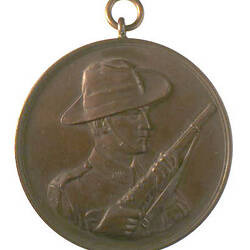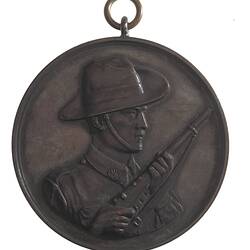Early in World War I local women's groups in Australia began working to provide provide tobacco, cakes, puddings, condensed milk, sugar, biscuits, newspapers and other 'luxury' items to supplement the Australian soldier's army rations. These fund-raising bodies were amalgamated in 1916 to form a national body, The Australian Comforts Fund (ACF), which undertook to provide 'comforts' to all Australians abroad. The formation of the ACF was announced in the Commonwealth Gazette of 31 August 1916.
The ACF grew into an enormous fundraising, collecting, sorting and distribution organisation that rivalled the Red Cross. Although men took some executive positions on national and state committees, the bulk of the administrative and manual work fell on a huge 'army' of unpaid women.
The Fund continued to send care parcels to Australians serving overseas, including letters, periodicals, extra clothing, food, tobacco and other 'comforts'. Socks were urgently needed, since soldiers could not wash or dry their socks in the mud and cold of the trenches, and Australian women and children knitted tens of thousands of socks. In the winter of 1916 alone the ACF provided 80,000 hand-knitted pairs of socks. The Soldiers' Sock Fund in Sydney sent away almost 21,000 pairs of socks each year. In part these activities expressed Australian women's desire to take an active role in World War I. Australian nurses served overseas, but Australian women were not mobilised for war work, and numerous volunteer organisations, such as the ACF, sprang up to offer more traditional assistance to the troops.
The ACF also provided food relief on the battlefield, illustrated in an image of tea service at the ACF buffet in Longueval, France, in December 1916 (Australian War Memorial collection). The Fund served more than 12 million such mugs of coffee and tea during World War I. Troops were deeply appreciative of the work of the Fund. 'We desire to acknowledge our debt to the Australian Comforts Fund. Their soup kitchen was the goal to which even the weariest man persevered during the dreadful outward journeys from the line'. (Extract from chapter on 'The Somme Winter 1916-1917' in The History of the 22nd Battalion).
The ACF was dissolved at the end of the War, but had proved such a success as a link between home and the battlefield that it was revived in 1940 to supply 'comforts' for a new generation of Australian soldiers.
References:
Picture Australia website http://nla.gov.au/nla, accessed 27/11/2003
State Library of Victoria website, World War I 1914-1918: Women and the War. http://www.statelibrary.vic.gov.au/slv/resources/ww1/wawaust.html, accessed 27/11/2003
Anzac Day website http://www.anzacday.org.au/miscellaneous/teacup.html, accessed 27/11/2003
Commonwealth Gazette, 31 Aug 1916, p. 1967
More Information
-
Keywords
-
Localities
-
Authors
-
Article types



